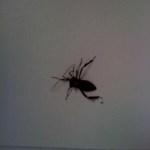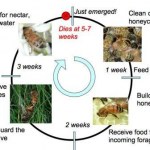Invertebrates
You've got to feel sorry for the female seed beetle. Whenever she mates with a male, she has to contend with his spiked, nightmarish penis (remember this picture?). And despite the damage that it inflicts, one liaison just isn't enough; female seed beetles typically mate with many males before they lay their eggs. Surely, she must benefit in some way?
The most likely idea is that she somehow ensures that her eggs are fertilised by sperm from males with the "best" genes - those that either make for particularly fit and healthy young, or that are a compatible match for the female's own genes.…
I am pretty sure it's a true bug (i.e., I am not being sloppy by calling just any ole' insect a bug). I got as close as I could with my iPhone, but the lighting was bad. This is on my porch and the bug is really large - about 1 inch in length of the body.
So, what is it?
Social insects like ants, bees and wasps are some of the most successful animals on the planet. By acting as large super-organisms, they can achieve things that larger singular creatures cannot.
Their astounding selflessness is driven by an unusual way of handing down their genes, which means that females actually have more genes in common with their sisters than they do with their own daughters. And that makes them more likely to put the good of their colony sisters over their own reproductive legacy.
The more related the workers are to each other, the more willing they will be to co-…
In 1979, somewhere in Dartmoor, a butterfly died. That would hardly have been an exceptional event, but this individual was a Large Blue butterfly (Maculinea arion) and it was the last of its kind in the United Kingdom. Over more than a century, the Large Blue's population had been declining and it was finally declared nationally extinct 30 years ago.
Now, it's back. A bold conservation effort managed to work out the factors behind the butterfly's decline, and resurrect this vanished species. The Large Blue's reintroduction has been one of conservation's flagship successes and it was the…
Where there are plants, there are almost certainly aphids feeding on them. These ubiquitous insects are banquets for many predators, and some have evolved incredible defences against them. The cabbage aphid, for example, is a walking bomb.
Its body carries two reactive chemicals that only mix when a predator attacks it. The injured aphid dies. But in the process, the chemicals in its body react and trigger an explosion that delivers lethal amounts of poison to the predator, saving the rest of the colony.
The aphids' chemical weapons are stolen from the plants they eat. Far from being…
The animal world is full of harmless liars, who mimic species more dangerous than themselves in order to avoid the attention of predators. But none do it quite like the dark-footed ant-spider Myrmarachne melanotarsa.
As its name suggests, this small species of jumping spider, discovered just nine years ago, impersonates ants. In itself, that's nothing special - ants are so aggressive that many predators give them a wide berth and lots of species do well by imitating them. The list includes over 100 spiders but among them, M.melanotarsa's impression is unusually strong. It doesn't just mimic…
In the darkness of the deep ocean, some animals create their own light. Among these is the Hawaiian bobtail squid Euprymna scolopes, which forms a partnership with the luminous bacterium Vibrio fischeri. The squid houses colonies of these bacteria in special light organs, and it can control the brightness and direction of their illuminations. But these organs do much more than produce light - they detect it too.
Deyan Tong from the University of Wisconsin has discovered that the organs generate nervous signals when they sense light and they're loaded with proteins responsible for detecting…
In 2005, corals in the large reef off the coast of Florida were saved by four hurricanes. Tropical storms seem to be unlikely heroes for any living thing. Indeed, coral reefs directly in the way of a hurricane, or even up to 90km from its centre, suffer serious physical damage. But Derek Manzello from the National Oceanic and Atmospheric Administation has found that corals just outside the storm's path reap an unexpected benefit.
Hurricanes can significantly cool large stretches of ocean as they pass overhead, by drawing up cooler water from the sea floor. And this cooling effect,…
Many plants depend so heavily on visits from bees that they go to great lengths to attract them, using brightly coloured flowers baited with sweet nectar. But some of their tricks are much subtler and are designed not to attract six-legged visitors, but to make their stay more convenient.
The majority of flowering plants have evolved special conical cells that line the surface of their petals and are found nowhere else. These cells provide the flower with a rougher texture that is indistinguishable to human fingers, but that provide just enough purchase for the claws of landing insects.…
In Mexico's Cueva del Azufre (the Sulphur Caves), a small fish called the shortfin molly (Poecilia mexicana) is on the way to becoming two separate species. Those that live in the dark interior of the caves are very different to their relatives that swim in the bright, surface waters. They have lighter colours and live more solitary lives. Their eyes are smaller, less sensitive and have lower levels of light-sensitive pigment. Instead, they rely instead on a hypersensitive pressure detector - the lateral line - to sense disturbances in the water.
Their differences aren't just skin deep…
Most people are aware that social insects, like honeybees, have three "sexes": queens, drones and workers.
Drones are males. Their only job is to fly out and mate with the queen after which they drop dead.
Female larvae fed 'royal jelly' emerge as queens. After mating, the young queen takes a bunch of workers with her and sets up a new colony. She lives much longer than other bees and spends her life laying gazillions of eggs continuously around the clock, while being fed by workers.
Female larvae not fed the 'royal jelly' emerge as workers.
Workers perform a variety of jobs in the hive.…
The success of termites Âand other social insects hinges on their complex social systems, where workers sacrifice the ability to raise their own young in order to serve the colony and its queen - the only individual who reproduces. But this social order can be thrown into chaos by knocking out a single gene, and one that originally had a role in that other characteristic termite ability - eating wood.
Judith Korb from the University of Osnabrueck in Germany found that the queen termite relies on a gene called Neofem2 to rule over her subjects. Korb worked with the termite Cryptotermes…
We recognise dead people by the absence of signals that indicate life - movement, responsiveness, pulses, brain activity, and so on. The Argentine ant does the same, but its signal is a chemical one. Throughout its life, an ant uses chemicals in its skin to automatically send out a message to its nest-mates, saying "I'm alive. Don't throw me out." When it dies, these "chemicals of life" fade away, and their bodies are evicted.
Social insects like ants and honeybees are fastidious about their colony's tidiness. If any individuals die, they're quickly removed and thrown away in one of the…
Impressionists are a mainstay of British comedy, with the likes of Rory Bremner and Alistair MacGowan uncannily mimicking the voices of celebrities and politicians. Now, biologists have found that tiger moths impersonate each other too, and they do so to avoid the jaws of bats.
Some creatures like starlings and lyrebirds are accomplished impersonators but until now, we only had anecdotal evidence that animals mimic each others' sounds for defence. Some harmless droneflies may sound like stinging honeybees, while burrowing owls deter predators from their burrows by mimicking the…
tags: TEDTalks, Margaret Wertheim, mathematics, evolution, sea slugs, coral reefs, streaming video
This interesting video discusses evolution, mathematics, sea slugs, corals and crocheting as presented by science writer Margaret Wertheim [16:37]
The courtship rituals of the spider Harpactea sadistica start innocently enough, with a dance and a hug. The male spider taps the female gently with his front legs and embraces her. But from that point onwards, things for the female go rapidly downhill. The male bites her and she becomes passive, allowing him to manoeuvre her into position. Like all spiders, his genitals are found next to his head, on a pair of appendages called the pedipalps. But unusually, his penis ends in a needle-sharp tip called an embolus.
The embolus sits at the end of a loop called the conductor. The male hooks one…
In the forests of Singapore lives a spider that must be an arachnophobe's worst nightmare. Most species are solitary hunters subdue their prey with venomous fangs, sticky silken webs or a combination of the two. But Scytodes uses a third trick - it spits a sticky, venomous fluid from its fangs that both traps its victims and poisons them (see video of related species). And it does this in packs - after hatching, spiderlings spend their early lives on their home web and they spit at, bite and devour prey en masse.
There are actually about 200 species of spitting spiders belonging to the genus…
For long journeys, the shell of a snail hardly seems like the ideal public transport. That is, of course, unless you're an even smaller snail...
Yasunori Kano from the University of Miyazaki has found that the babies of Neritina asperulata, a tiny snail just 3 millimetres across, hitchhike on the back of a larger species Neritina pulligera. This living bus is about 2 centimetres long, and dwarfs its passengers by more than seven times.
The hitchhiking snail is a special sort of parasite, and one that Kano thinks has never been described before. They don't use their hosts as a snack, a home…
Sponges are among the most primitive of all animals. They are immobile, and live by filtering detritus from the water. They have no brains or, for that matter, any neurons, organs or even tissues. If you were looking for the evolutionary origins of animal intelligence, you couldn't really pick a less likely subject to study.
So it was with great surprise that Onur Sakarya from the University of California, Santa Barbara found that sponges carry the beginnings of a nervous system.
With no neurons to speak of, these animals still have the genetic components of synapses, one of the most…
We get a lot of information from watching other people. We read reviews, we follow links to recommended websites and we listen when our friends vouch for strangers. The opinions of strangers may even be a better guide to the things that make us happy than our own predictions. But humans aren't the only species to make decisions based on information gleaned from our peers - even animals as supposedly simple as flies can do the same.
Frederic Mery from LEGS (the Laboratory of Evolution, Genomes and Speciation) studied the fly Drosophila melanogaster and found that females have a tendency to…

